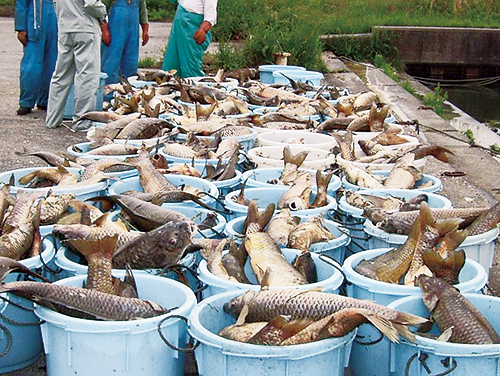Effects of Environmental Change on the Interactions between Pathogens and Humans
2013 CR2

by Masatomi Matsuoka [2010] In: The RIHN Encyclopedia of Global Environmental Studies, Koubundou, p. 284.
The rapid spread of emerging infectious diseases is a serious global environmental problem that threatens not only humans, wildlife, and livestock worldwide, but also induces economical loss and collapse of ecosystems. This project aimed to verify the hypothesis that human mediated environmental degradations cause and spread infectious diseases by studying Koi herpesvirus (KHV) disease (Photo) as a model. Based on the analyses of environment–pathogen–human interactions, we also tried to suggest ways to prevent or minimize the emergence and communication of infectious diseases, and to enhance social ability to cope with them.
▲PAGE TOPProject achievements
Analysis of the links between lakeshore degradation, KHV, and human activity in Lake Biwa, Japan allowed partial verification of the hypothesis that anthropogenic alterations of the environment facilitate outbreaks and spread of infectious diseases. A conceptual model we developed of the environment–pathogen–human linkage derived from KHV disease in Lake Biwa helped us to understand the causes of other cases of infectious disease, such as schistosomiasis in Kenya, fish diseases in the Pin River at Chaing Mai, Thailand, and Legionella disease, MRSA, Norovirus disease, and nontuberculous mycobacteria disease in Japan.
Contributions to global environmental studies
We discovered that there is an important environmental component to infectious disease. While pathological studies inform effective disease treatment, the study of the interactions between pathogen, host and human actions that may create or alleviate ‘fertile’ disease environments is necessary for prediction and prevention of new disease outbreaks.
We found that since the outbreak of KHV disease in Lake Biwa was first documented, KHV is now found throughout the lake ecosystem, including in plankton and sediment, in many lagoons and ponds, as well as in almost all the rivers of Japan. This finding indicates that it is impossible to eliminate KHV directly, and that instead it is necessary to practice precautionary environmental management to eliminate ‘fertile’ disease environments. In order to reduce future outbreaks of infectious disease, it is necessary to understand links between environments, pathogen, host, and humans in addition to the ‘natural’ behaviors of pathogen and host.
The finding that anthropogenic environmental changes mediate disease outbreaks and spread led us to consider how interactions between pathogens and humans can be modified for long-term societal benefit. From the view point of human ethics, we suggest that humans often have responsibility for outbreaks and spread of infectious disease.
Dissemination of the research results for a worldwide research network
We shared our research methods and results and our concept of infectious diseases as ‘environmental disease’ with international and national academic communities and society. Project findings were introduced to academic communities in a general paper, more than 30 specific papers on environment–pathogen–human linkages, 10 edited special articles, and six project-organized international conferences, as well as through invited lectures at universities in several Asian countries. These activities formed the base of an international alliance of researchers studying environmental disease while also promoting activities that can help address infectious disease worldwide.
▲PAGE TOP